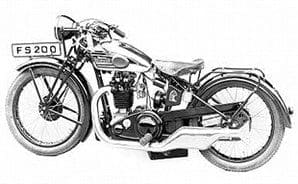
Standard 1925-c52 Germany and Switzerland
Standard founder Wilhelm Gutbrod was previously associated with the Klotz marque, which specialised in excellent 246cc two-stroke models that performed well in national trials and at speed events. Gutbrod launched Standard (Standard Fahrzeugfabrik GmbH of Ludwigsburg) with a couple of 246/348cc ohv models, in effect tourers with sporting pretensions. The range was quickly expanded to include up to 1000cc ioe V-twin MAG engined models. Soon the entire line-up was powered by Swiss MAG units but JAP was available to special order and for selected racing models.
Wilhelm later adopted the Dougal Marchant designed ohc MAG engines for racing and other speed models although continued to use ohv JAP V-twin units for 1000cc racing machines. During the late 1920s, for many models except the smaller lightweights, Gutbrod began using Brough Superior (Castle) type front forks, built under licence in Germany. George Brough in turn had developed these from a Harley-Davidson concept. For 1929-30 models included the 500BS with ohv MAG single cylinder engine, sporting and touring 500s with MAG ioe power, a 350cc model and a 750cc side-valve MAG-engined V-twin.
Throughout their production run Standard concentrated on quality rather than build motorcycles to a price. They used much of the MAG range of engines with side-valve, ohv, ohc, ioe or eoi valve configuration, JAP ohv singles initially and later some ohv singles and V-twins for racing models.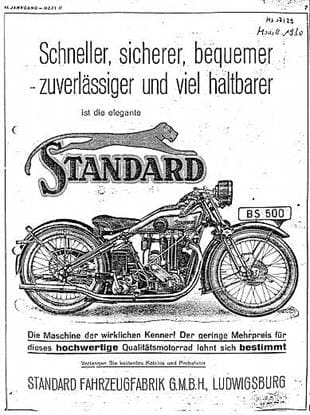
They drew on the best available German made proprietary parts including Bosch magnetos and magdynos – even to Bowden type cable and trigger lever operated headlight dipping mechanism, Hurth gearboxes (Burman like) Fischer carburettors and top quality rubber saddles.
By 1930-31 Standard were marketing a new range of over-the-counter racers and introduced in the early 1930s a selection of light to medium weight models again with JAP power, but this time the JAP engines were built in Germany under licence from JAP of London. Precise history is hazy but c1930-32 Gutbrod bought the Swiss Zehnder motorcycle factory, which he continued to run, and established a Standard subsidiary factory, also in Switzerland, which predominantly specialised in larger capacity machines, usually with MAG power.
Ever keen to enlarge his business, Wilhelm Gutbrod began making Josef Ganz designed 494cc and 396cc twin cylinder two-stroke engined small cars. Of attractive design with beetle back bodywork, the larger engined models were marketed as the Standard Superior – clearly Gutbrod had taken his business friendship with George Brough a stage further!
By the mid-1930s Standard was offering a range of up to 248cc two-stroke motorcycles, although larger more luxurious models continued in the catalogue for some time.
After WWII the family factory was involved in engineering and the production of agricultural machinery but they tried to re-enter the motorcycle market – first with up to 248cc two-stroke models and then a small range of ohv machines in prototype form. In reality, few two-strokes were actually built or sold and it’s doubtful any post WWII four-strokes went into production.
After Wilhelm’s death in the years immediately following WWII, his sons ran the business and oversaw both the low level motorcycle development and the reintroduction of car production with 593cc and 663cc twin cylinder two-stroke powered small cars, which were in production 1950-54. When car and motorcycle involvement ended the Gutbrod family business continued with agricultural machinery manufacture, later adding horticultural equipment to their range.
Neither Wilhelm Gutbrod nor his sons knew how to build ‘cheap’ products, thus enthusiasts today can be assured of a good quality buy if they are lucky enough to find a Standard.
Stanger 1921-23 UK
Built by the Stanger Engineering Company of 13 Steeple Road, Tottenham, London, this unusual machine comprised a V-twin two-stroke engine housed in a sprung frame. The 539cc 45-degree V-twin engine used deflector pistons and most examples drove the rear wheel via chain-cum-belt transmission and three-speed Sturmey Archer gearbox. Priced at £97 solo and £123 for the combination, the Stanger was built in small numbers. There is one known survivor.
Star
Much confusion exists regarding the manufacture of Star vehicles, of which there were at least three and possibly four distinct motorcycle makers and four car makers.
Star 1898(1895)-1900 Germany
Claimed maker (assembler) of Werner motorcycles under licence. If reports are correct they were of early Werner design only with engine mounted over the front wheel, with drive by belt. Some sources claim assembly started in 1898, which fits with Werner production, while others suggest 1895. The 1895 date is doubtful as Werner manufacture started hesitantly in 1897 with increased volume the following year.
Star 1898-1914 UK
Wolverhampton based Star Engineering Company founded by Edward Lisle who began building cycles in 1883. Car production began in 1897 with a 31⁄2hp Benz based vehicle; tricycle assembly started the following year. Alongside a growing car business Star introduced De Dion engined motorcycles c1901, later replaced by the assembly of small numbers of French Griffons built under licence.
By 1910/11 Star began building small numbers of well equipped JAP single and V-twin engined machines, which continued in low level production until WWI. Car manufacture, predominantly aimed at the luxury end of the market, continued until 1932. Unaware of any motorcycle survivors, although a moderate number of cars and tricycles dating from late Victorian times onwards are known.
Star 1919-21 UK
Maker of 269cc Villiers engined lightweights, assembled from proprietary parts including frame kits. At least a couple of examples survive.
Star 1920-22 Germany
Maker of Douglas-like 393cc fore-and-aft flat twins, which became the D-Rad in 1921/22.
Starley c1902-06 UK
Famous Victorian and Edwardian cycle maker that was at the forefront of cycle and tricycle racing. The firm developed a successful differential gear for its racing tricycle, the design of which was later adapted and adopted by car makers. Starley designed an advanced 317cc four-stroke motorcycle with its engine built in unit with a two-speed gearbox.
Mounted with its crankshaft running transversely across rather than in line with the frame, it drove the rear wheel via a worm and bevel gear, then chain final drive. The much later Cyc-Auto and Scott Cyc-Auto – although two-strokes – employed the same transverse engine concept and worm drive principles.
It’s doubtful Starley ever built any production motorcycles as Mr Starley quickly became involved with the automotive world due to his successful differential designs and later work. Swift (who were for a time associated commercially with Ariel) built the Starley designed motorcycles, which were marketed under both the Swift and Starley brands. Survivors of both exist, of which a Swift was once a Pioneer Run regular.
Stella 1921-53 France/Belgium
Once a well respected maker whose main premises was at 1 rue d’Issy, Billancourt, France. Many sources state the Belgium based concern, which ceased trading in 1936, was associated with the French factory. Stella often employed advanced thinking to their designs, including pressed steel frames for some later models, which were made alongside the conventional tubular frames for customers who had more conservative tastes.
Production began with a 98cc two-stroke Velo Moto which, like the earlier Motosaccoche, could be bought as a complete machine or as a unit mounted in a subframe for fitting within the frame diamond of a conventional gentleman’s cycle. Stella later developed a range of 175-500cc two- and four-stroke motorcycles powered by JAP, Chaise and LMP engines. During pre-WWII production JAP engines were replaced by Staub units, some of which were JAP engines built under licence in France by Staub.
Sterling-Sterva 1920-56 France
Small volume cycle maker from Saint Etienne, which began its foray into the motorcycle world with cyclemotor attachments. Following years of intermittent production of ultra lightweight autocycle-type machines and cyclemotors, Sterling launched a range of Sterva scooters in 1952. The Sterva scooters were also built under licence in Belgium by the Van Hauwaert company, which used the Minerva transfer.
Looking near identical to the large wheeled (for a scooter!) Moto Rumi Scoiattolo, the first models were identified as the JV125 powered by Ydral 125cc two-stroke proprietary engines soon followed by the 175cc Ydral engined JV175.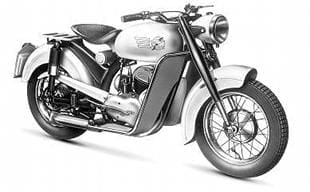
In an attempt to attract more customers the Sterva was later catalogued with a range of engine options including the 125cc Nervor, 125cc SAAB (SABB) – product of Etablissements Rene Briban – and 175cc Sachs units. A number of scooters survive along with a few cyclemotor units.
Sterzi 1939-c1962 Italy
Small factory from Palazzolo sull’Oglio, which briefly began with 100/125cc Sachs engined two-stroke lightweights before the outbreak of WWII. Due to the industrial hardships in Italy after the war production didn’t restart until 1948, beginning with a range of well made, attractive up to 175cc two-stroke lightweights to which a range of ohv valve models from the 60cc Pony to 174cc motorcycle were added. Also briefly built a 160cc two-stroke scooter in the late 1950s.
Stevens 1932-8 UK
Despite the banks forcing the AJS factory into liquidation in 1931 (historical evidence proves the company although financially struggling was more than solvent) the Stevens family retained ownership of their Retreat Street, Wolverhampton works and the Stevens Screw Company Ltd, which was founded by Joe Stevens (senior) in 1906.
Formed in May 1932, Stevens Brothers (Wolverhampton) Ltd employed a small group of workers, many from their AJS days, and volunteers who worked morning, noon and night to develop and put into production the Stevens Light Commercial Vehicle. Much to the delight of the five Stevens brothers, members of local industry, trade and commerce chipped in to help, often for no financial reward.
The light commercial was in effect a small three-wheeled box van with a 5cwt payload, its single front wheel supported in a heavyweight motorcycle type girder front fork. Powered by a water-cooled 588cc side-valve Stevens engine, drive was via a three-speed Burman gearbox boasting reverse facility with a semi floating differential and chain final drive. The transmission was later modified after early drivers reported regular chain breakages, especially if overloaded.
Cheap to run and repair, the vans soon found favour for local work. Early models had no front doors, which were later added to keep drivers dry and warmer in winter. Production was initially in batches of six (soon increased) and arrangements were made with the London firm Bowden (Engineers) Ltd to build further models at their works for marketing in the London area. Despite this modest success, two brothers – Joe and Jack – left to take up positions with the Wolverhampton Auto-Machinists Ltd, as t hey realised the small firm could no longer support five directors.
hey realised the small firm could no longer support five directors.
Billie, George and Harry remained to expand once again into motorcycle production, first by making engines for OK Supreme and AJW. Then in March 1934 came the first complete Stevens motorcycles, the ohv 250cc DS1 and US2 designed by Harry Stevens.
Through the season the model was improved in detail and then revised for the 1935 season. This development was soon followed by the launch of a 350cc ohv single (HL3 and LL4) and in April 1935 came the 500cc version (HP6 and LP5). Although there were a number of detail differences between the models in each capacity, the clear visual difference was exhaust pipe style. DS = downswept, US = upswept, HL = high level, LL = low level, HP = high pipe and LP = low pipe. Options included competition spec models.
George Stevens took over sales and embarked on an export drive, including to Japan. In autumn 1935 the motorcycle range was given a cosmetic facelift and the commercial three-wheeler gained an increased payload, other refinements and shaft drive to rear wheels. Offered with either open pick-up or van type bodywork, the lightweight three-wheeler was modestly priced at 89 guineas (£93-45).
Through 1936 Stevens machines earned a fine reputation in the competition world led by works rider – and chief factory tester – Tommy Deadman. For the following season models were again modestly updated, some with larger fuel tanks and/or megaphone exhausts. During 1937 development began in conjunction with George Brough of Nottingham on a four-cylinder engine for mating with a four-speed gearbox for Brough’s proposed Brough Superior 1000cc Dream or Golden Dream. The concept was stillborn, although a single prototype survives.
After about 1000 motorcycles had been built, Stevens production ended in 1938, the brothers reasoning they wouldn’t secure any contracts to build motorcycles for the coming war as they were a small concern. Instead they developed their general engineering business working for the Ministry of Aircraft Production during WWII. Although motorcycle manufacture had ended, two machines were later built from spares for a new generation of Stevens. The last remaining brother in the business, Jack, died in 1956 and the Stevens Screw Company Ltd closed in December 1992, ending the Stevens contribution to the Wolverhampton engineering industry. A reasonable number of Stevens machines survive, and of fine quality they command strong prices.
Stock 1924-33 Germany
Berlin based company, part of the Kuhn empire, which began motorcycle production making 119cc two-stroke machines built under licence from the American Evans concern. Later built a range of typically German shaft drive 175 to 350cc two-stroke single cylinder motorcycles, with double cradle frames. Also built a small number of water-cooled racers. Small numbers of survivors but none seen on the open market in recent years.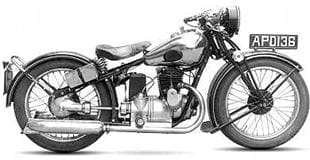
Strolch 1950-51 (1960) Germany
Stuttgart based company that built a range of Gassman designed scooters using 98-198cc Sachs two-stroke engines. Most production models sported 16in wheels and a headlight mounted on the front shield that turned direction with the wheel.
The range of Strolch (Vagabond) scooters was soon renamed the Progress Strolch. Later, as scooters were updated, the name Strolch was dropped and the novel pivoting headlamp was also discontinued in 1958. Strolch, Progress Strolch and Progress scooters are a different collector’s item but don’t command higher prices.
Stucchi 1901(1898)-1927 Italy
As an apprentice, the renowned car maker Ettore Bugatti worked for the fledgling Prinetti and Stucchi concern building motor tricycles, motorcycles, small twin cylinder cars and quads (tricycles with the front fork carrying two front wheels) before spending time variously at De Dietrich, Mathis and Deutz, then founding his own business in 1909.
In 1901 the Stucchi brand was adopted for most motorcycles, although the Prinetti and Stucchi name was kept alive until c1911. Along with many rival makers, single speed belt drivers gave way to models with gearboxes and all chain drive before the outbreak of WWI.
Later, the single cylinder range was complemented by worthy V-twins. Despite updates sales dwindled to almost nothing due to tight economic times and motorcycle manufacture ended. Other famous Stucchi designers included Carlo Leidi and Adalberto Garelli.
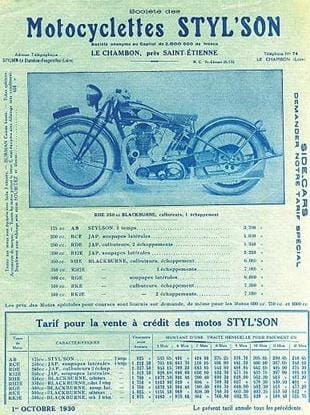 Styl’son 1919-1934 France
Styl’son 1919-1934 France
Small maker from Le Chambon Feugerolles which built attractive and at times fast motorcycles using predominantly Blackburne, JAP and Staub (JAP units built under licence in France) single and V-twin engines. Favouring powerful OHV valve engines, Styl’son later fitted large brakes and many models from mid-1920s onwards sported distinctive shallow, diamond-shaped silencers with fish tails.
Actively campaigned at continental race events, with Pierre Amort scoring wins with his 996cc JAP engined Styl’son outfit.
Suecia 1928-40 Sweden
Built a range of JAP single-cylinder powered models and also marketed Belgian built Sparta two-strokes under the Suecia brand.
Sulky 1954-57 France
Motobloc of Vichy began with autocycle and moped type machines then launched the French AMC two-stroke engined (98-124cc) mini scooters.



